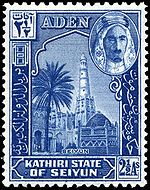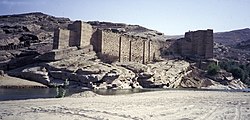Kathiri
| Hadhrami Kathiri Dynasty in Seiyun ٱلدَّوْلَة ٱلْكَثِيْرِيَّة ٱلْحَضْرَمِيَّة فِي سَيْؤُوْن ٱلْكَثِيْرِي al-Kathīrī | |||||||||||||
|---|---|---|---|---|---|---|---|---|---|---|---|---|---|
| State of the Aden Protectorate and the Protectorate of South Arabia | |||||||||||||
| 1395–1967 | |||||||||||||
Coat of Arms[1]
| |||||||||||||
 Map of the Protectorate of South Arabia 1965 | |||||||||||||
| Capital | Say'un | ||||||||||||
| Area | |||||||||||||
| • Coordinates | 17°10′N 50°15′E / 17.167°N 50.250°E | ||||||||||||
| Population | |||||||||||||
• 1952 | 60,000 [2] | ||||||||||||
| • Type | Sultanate | ||||||||||||
| Historical era | Middle Ages to Cold War | ||||||||||||
• Established | 1395 | ||||||||||||
• Disestablished | 30 November 1967 | ||||||||||||
| |||||||||||||
| Today part of | |||||||||||||
| EB | |||||||||||||
| Part of a series on the |
| History of Yemen |
|---|
|
|
Kathiri (
History
The Kathiri state was established in 1395 by Badr as-Sahab ibn al-Habrali Bu Tuwairik, who ruled until c. 1430. The country inhabited by this tribe was formerly extensive, reaching from the Aulaqi districts on the west to the Maliri tribe on the east, and including the seaports of 
At the end of 1883, Sultan Abdulla bin Salih, one of the Kathiri Shaikhs, visited the Resident at Aden. His principal object was to ascertain what attitude the British Government would maintain in the event of the Kathiri attacking the Qu'aiti with a view to repossessing themselves of the ports of Shihr and Mukalla. Abdulla bin Salih also visited Zanzibar with intent to intrigue with the ex-Naqib of Mukalla, from whom however, he failed to obtain any material assistance.[5]
The Government of India in March 1884 directed that the Kathiri be warned that an attack upon Shihr and Mukalla would be viewed with grave displeasure, and that, if necessary, a gun-boat would be sent to support the Qu'aiti ruler. The Jamadar of Shihr and Mukalla was subsequently assured in the most public manner that the Government would support him in the event of any attack on his ports.[5]
In 1895, the Kathiri captured the port at Dhufar, driving out the Governor, who retired to Mirbat. In 1897 the port was recaptured.[5] In 1918, a long standing Qu'aiti-Kathiri quarrel was settled, with the assistance of the Aden Residency, by the conclusion of an agreement between the parties, by which the Kathiri agreed to accept as binding upon them the treaty of 1888 between the Qu'aiti and the British Government and also accepted the arbitration of the British Government in the settlement of future disputes.[5]
Sultan Mansur bin Ghalib died at Mecca in May 1929 and was succeeded by his son Ali bin Mansur.[5]
The Kathiri State declined to join the
The first
References
- ^ Topol, Tom (9 March 2021). "Did you ever heard of a Seiyun passport?". Passport-collector.com. Retrieved 24 July 2023.
- ISSN 0026-3141.
- ^ Gordon, Bruce. "Regnal Chronologies – Arabia". Archived from the original on 24 July 2020.
- ISBN 978-0-903983-14-3.
- ^ a b c d e f Aitchison, G (1931). A Collection Of Treaties, Engagements And Sanads Relating To India And Neighbouring Countries. Vol. xi. Government of India. pp. 30–31.
 This article incorporates text from this source, which is in the public domain.
This article incorporates text from this source, which is in the public domain.
- ^ Stark, Freya (1936). The Southern Gates of Arabia: A Journey in the Hadhramaut. Retrieved 21 November 2021.
- ^ Oron, Yitzhak, ed. (1960), Middle East Record, vol. 1


![Coat of Arms[1] of Kathiri](http://upload.wikimedia.org/wikipedia/commons/thumb/e/ec/Emblem_of_the_Kathiri_State.png/120px-Emblem_of_the_Kathiri_State.png)



